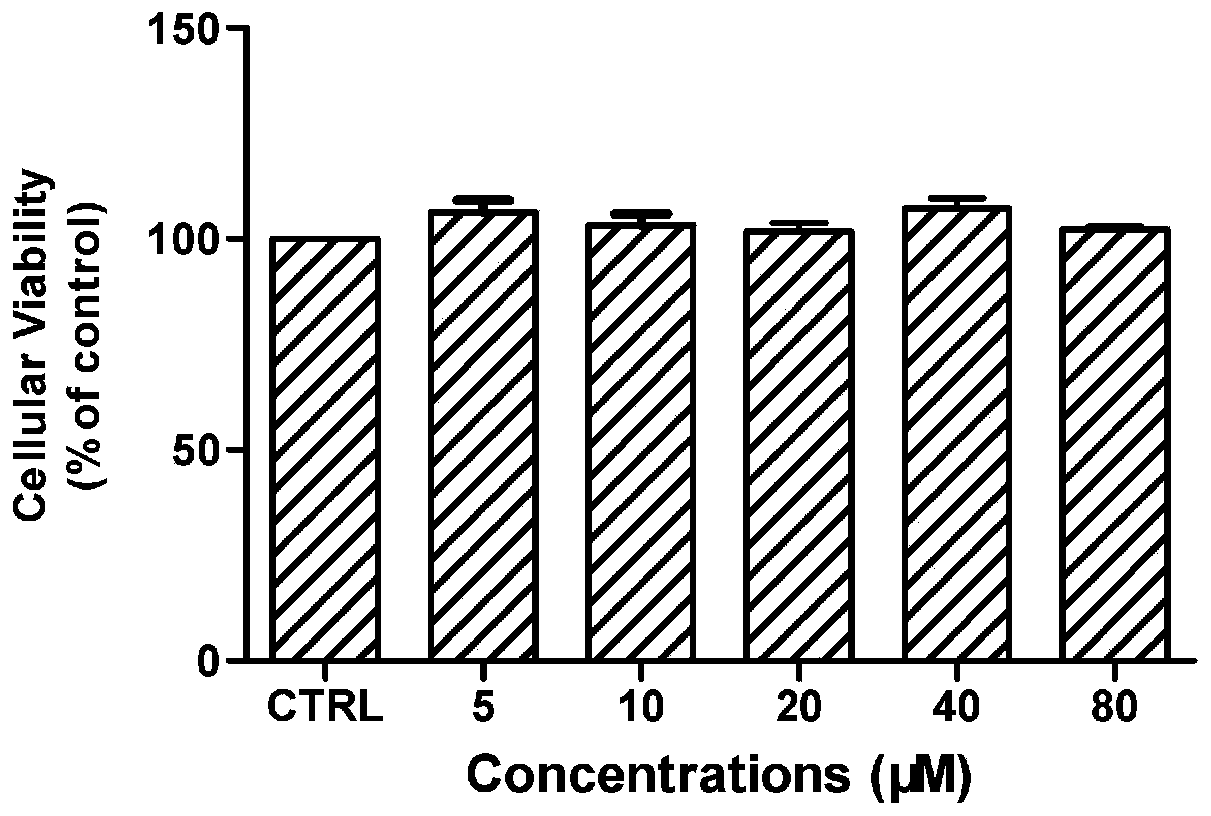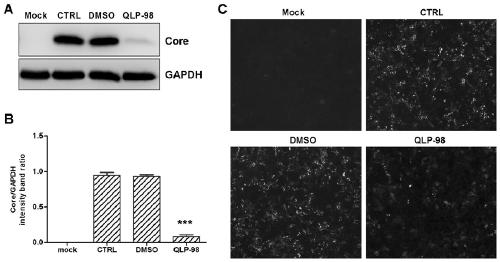Purpose of synthetic peptide to preparation of medicine for preventing and treating hepatitis virus infection
A hepatitis C virus and synthetic peptide technology, which is applied in the field of biomedicine, can solve the problems of low virus response rate, high toxicity and side effects, drug resistance variation, etc., and achieve the effect of simple and convenient purification process, low production cost and small side effects
- Summary
- Abstract
- Description
- Claims
- Application Information
AI Technical Summary
Problems solved by technology
Method used
Image
Examples
Embodiment 1
[0027] Embodiment 1: Synthetic peptide inhibits the effective concentration screening experiment of HCV infection
[0028] 1.1 HCV infection experiment of Huh7.5.1 cells
[0029] Normal Huh7.5.1 cells were cultured in DMEM medium containing 10% fetal bovine serum at 37°C, 5% CO 2 Culture in an incubator with saturated humidity, and add 2mM L-glutamine, 0.1mM non-essential amino acids, 100μg / mL streptomycin and 100U / mL penicillin to the cell culture medium.
[0030] The day before infection, Huh7.5.1 cells were divided into 3 × 10 4 cells / well were seeded in a 96-well cell culture plate, placed at 37°C, 5% CO 2 Incubate overnight in an incubator. On the next day, first suck out the culture supernatant, rinse twice with pre-warmed PBS, inoculate HCV with a viral load of MOI=1, infect at 37°C for 5 hours, discard the virus solution, rinse three times with pre-warmed PBS, and replace with Fresh culture medium was cultured at 37°C for 48 hours, and the positive cells infected w...
Embodiment 2
[0045] Example 2: Cytotoxicity Test of Synthetic Peptides
[0046] The CCK-8 method was used to detect the effect of adding synthetic peptides on the proliferation of Huh7.5.1 cells, and the specific steps were as follows:
[0047] Collect Huh7.5.1 cells in the logarithmic growth phase at approximately 3×10 4 seeded in 96-well plates. After the cells grew overnight, the synthetic peptides of various concentrations in Example 1 were added, and the culture was continued for 48 hours, and then the cell proliferation was detected by the CCK-8 method. The specific detection method is as follows: discard the original medium in the cells, add 110 μL of fresh medium containing 10 μL CCK-8 to each well, place it in a 37°C incubator and continue to cultivate for 3 hours, and then use a multi-functional microplate reader to detect at a wavelength of 450nm The absorbance value of each well. The experiment was repeated three times independently, and the mean and standard error were calc...
Embodiment 3
[0049] Embodiment 3: the experiment that synthetic peptide suppresses HCV protein expression
[0050] 3.1 Inhibition experiment of synthetic peptides on HCV infection
[0051] The day before infection, Huh7.5.1 cells were divided into 2 × 10 5 cells / well were seeded in 24-well cell culture plates, placed at 37°C, 5% CO 2 Incubate overnight in an incubator. On the next day, the culture supernatant was first aspirated, rinsed twice with pre-warmed PBS, and HCV was inoculated at a viral load of MOI=1, in which 80 μM of the above-mentioned synthetic peptide QLP-98 was added, and after infecting the cells for 5 hours, the viral liquid was discarded. Replace with fresh culture medium and continue culturing for 48 hours, and detect the expression of virus protein by Western blotting.
[0052] 3.2 Western blotting to detect the expression of HCV Core protein
[0053] 3.2.1 Preparation of cell samples
[0054] After the cells in the control group and synthetic peptide treatment gr...
PUM
 Login to View More
Login to View More Abstract
Description
Claims
Application Information
 Login to View More
Login to View More - R&D
- Intellectual Property
- Life Sciences
- Materials
- Tech Scout
- Unparalleled Data Quality
- Higher Quality Content
- 60% Fewer Hallucinations
Browse by: Latest US Patents, China's latest patents, Technical Efficacy Thesaurus, Application Domain, Technology Topic, Popular Technical Reports.
© 2025 PatSnap. All rights reserved.Legal|Privacy policy|Modern Slavery Act Transparency Statement|Sitemap|About US| Contact US: help@patsnap.com



